This article contains affiliate links. Learn more.
When it comes to premium acoustic guitars, two names consistently stand at the forefront of the conversation: Martin and Taylor. These legendary American guitar manufacturers have shaped the sound of modern music for generations, each with their distinctive approach to craftsmanship, tone, and playability. Whether you’re a seasoned guitarist looking to invest in your next instrument or a beginner wanting to understand the differences between these iconic brands, this comprehensive guide will help you navigate the nuanced world of Martin and Taylor acoustic guitars. All photos below are courtesy of their respective parties.
If you’re a beginner guitar player, check out our article on how to choose your first guitar.
Table of Contents
- 1 A Tale of Two Guitar Legends
- 2 Distinctive Tonal Characteristics
- 3 Body Styles and Design Philosophy
- 4 Playability Considerations
- 5 Manufacturing Approaches
- 6 Tonewoods and Materials
- 7 Notable Model Series Comparison
- 8 Electronics and Amplification
- 9 Player Experience and Feel
- 10 Making Your Choice: Which is Right for You?
- 11 Conclusion: Two Paths to Excellence
A Tale of Two Guitar Legends
Martin’s Rich Heritage
The C.F. Martin & Company story begins in 1833, making it one of the oldest guitar manufacturers in the world. Founded by Christian Frederick Martin Sr., a German immigrant who brought European craftsmanship to America, the company established itself in Nazareth, Pennsylvania, where it remains to this day. Martin’s nearly two centuries of guitar-making expertise has resulted in innovations that fundamentally shaped the modern acoustic guitar.
Martin is credited with developing the dreadnought body style in the early 20th century—arguably the most influential acoustic guitar design ever created. This larger-bodied guitar was designed to produce more volume and bass response in an era before amplification, allowing guitarists to be heard alongside other instruments. Today, the dreadnought remains Martin’s signature shape and has been widely adopted by virtually every acoustic guitar manufacturer worldwide.
Taylor’s Modern Innovation

In contrast to Martin’s centuries-old legacy, Taylor Guitars represents a more contemporary chapter in American guitar craftsmanship. Founded in 1974 by Bob Taylor and Kurt Listug in El Cajon, California, Taylor brought fresh perspectives and modern manufacturing techniques to the tradition-bound world of acoustic guitars.
While relatively younger, Taylor has established itself as an industry leader through consistent innovation. The company pioneered the use of computer-assisted design and precision manufacturing in acoustic guitars while maintaining high standards of craftsmanship. Perhaps most notably, Taylor developed the NT (New Technology) neck, a revolutionary design that improved neck stability, intonation, and ease of service—addressing common pain points for guitarists.
Distinctive Tonal Characteristics
The Martin Sound
When guitar enthusiasts discuss the “Martin sound,” they’re typically referring to a rich, warm tone with pronounced bass response and complex overtones. Martin guitars are known for their powerful projection and remarkable balance across the frequency spectrum. The bass is robust without being boomy, the midrange is present without being harsh, and the treble has a sweet, bell-like quality.
Martin achieves this signature sound through several key elements:
- Traditional bracing patterns: Martin’s X-bracing (invented by the company in the 1850s) provides structural integrity while allowing the top to vibrate freely.
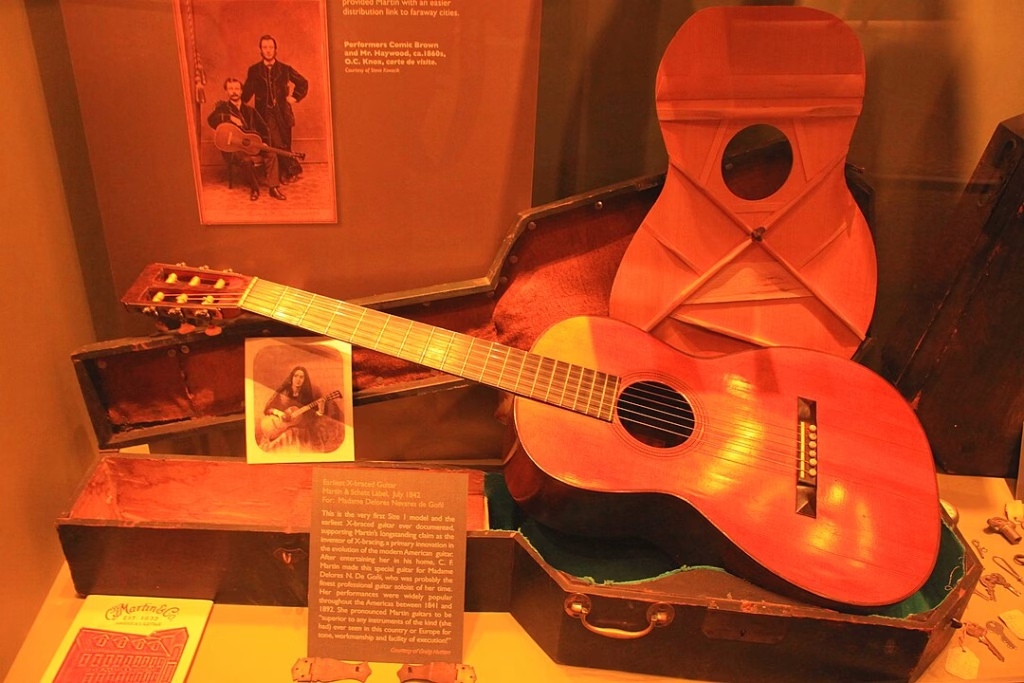
Earliest X-bracing on size 1 guitar by Martin & Schatz, manufactured by C.F. Martin & Company in July 1842. By Joseph Brent from New York, USA
- Solid tonewoods: Martin’s commitment to high-quality tonewoods, particularly Sitka spruce tops paired with rosewood or mahogany back and sides, contributes significantly to their distinctive tone.
- Hand-crafted construction: Many Martin models still incorporate significant hand-craftsmanship, with skilled luthiers shaping braces and assembling components using techniques passed down through generations.
The Martin tone is particularly well-suited for flatpicking, strumming, and traditional styles like bluegrass, folk, and country. When you listen to iconic acoustic guitar recordings from artists like Johnny Cash, Neil Young, or Joni Mitchell, you’re often hearing the distinctive voice of a Martin guitar.
The Taylor Sound
Taylor guitars produce a bright, articulate sound with exceptional clarity and definition. Compared to Martin, Taylor guitars typically offer more pronounced treble response, greater string-to-string separation, and a more immediate attack. This results in a modern, balanced tone that many players describe as “piano-like” in its clarity.
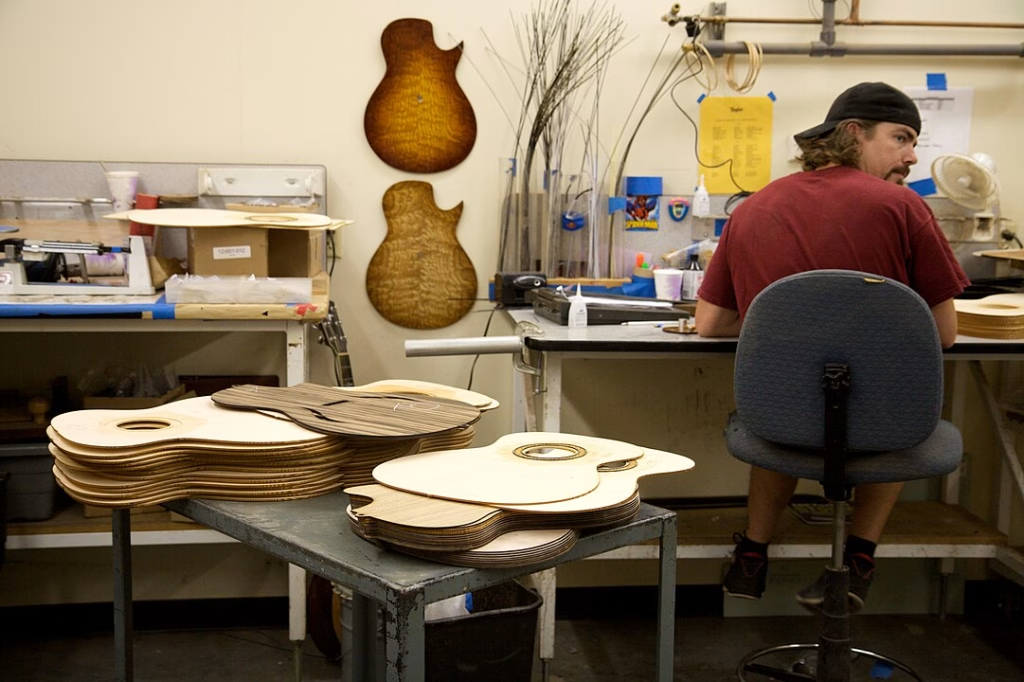
Pictured: TGFT18 body top & backs at the Taylor Guitar Factory – by Marcin Wichary
Several distinctive elements contribute to the Taylor sound:
- V-Class bracing: Taylor’s innovative V-Class bracing design (which replaced their earlier forward-shifted X-bracing) enhances sustain, volume, and intonation, creating their signature contemporary tone.
- Precision neck joint: The patented NT neck design ensures consistent neck angle and intonation, contributing to Taylor’s reputation for playability and clear tone.
- Modern manufacturing: Taylor’s blend of precision manufacturing with hand-craftsmanship results in remarkable consistency across instruments.
Taylor guitars excel in fingerstyle playing, contemporary strumming styles, and recording environments where clarity is paramount. Artists like Taylor Swift, Jason Mraz, and Zac Brown have helped popularize the Taylor sound in modern acoustic music.
Body Styles and Design Philosophy
Martin’s Traditional Approach
Martin’s lineup centers around several classic body styles, each with distinct tonal characteristics:
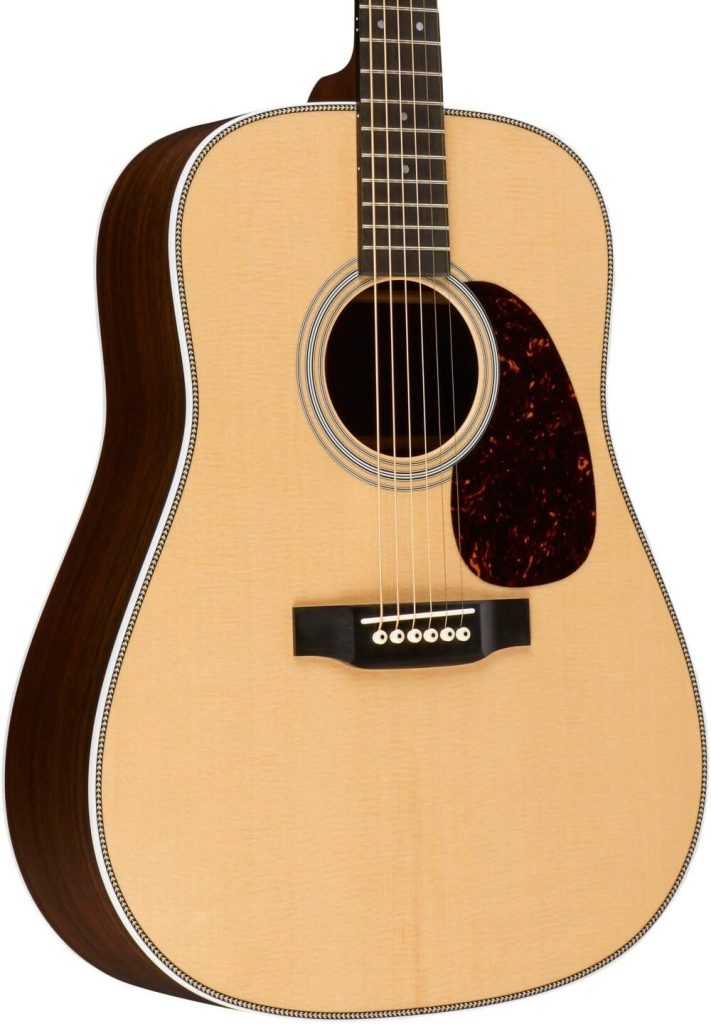
Pictured above: Martin Standard Series HD-28 Standard Dreadnought Acoustic
Dreadnought (D): Martin’s flagship design offers powerful bass response and volume, ideal for strumming and flatpicking. The HD-28 and D-18 are quintessential examples that have influenced countless songs across multiple genres.
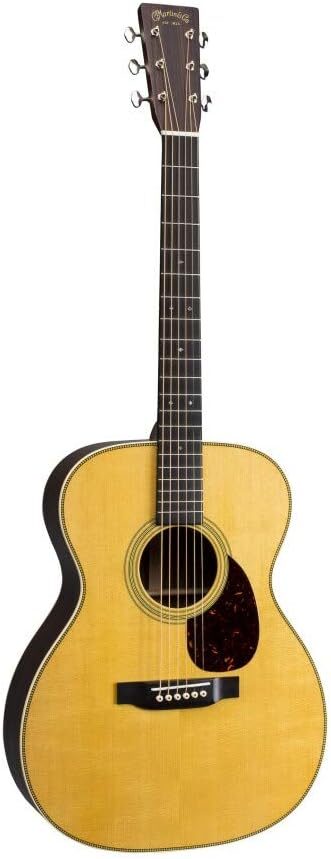
Pictured above: Martin OM-28
Orchestra Model (OM): A more balanced design with a slightly smaller body than the dreadnought, offering enhanced midrange and greater comfort for many players. The OM-28 exemplifies this versatile design.
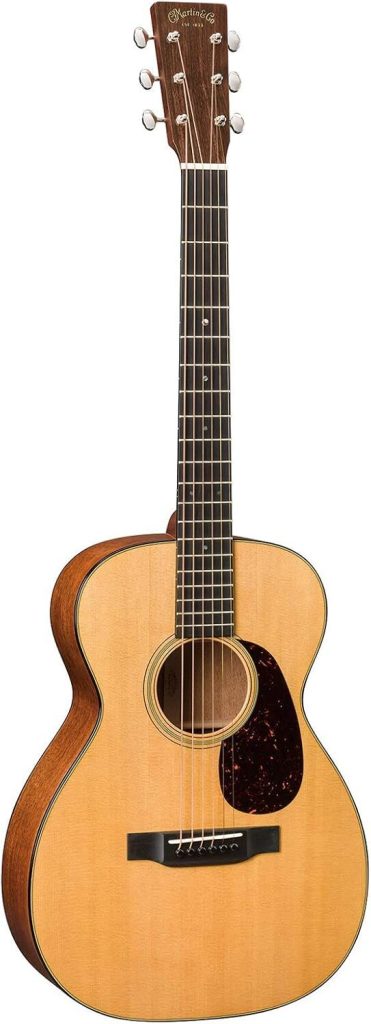
Pictured above: Martin 0-18
0, 00, and 000 Series: These progressively larger “concert” body styles provide more focused sound with excellent balance, making them favorites for fingerstyle players and vocalists.
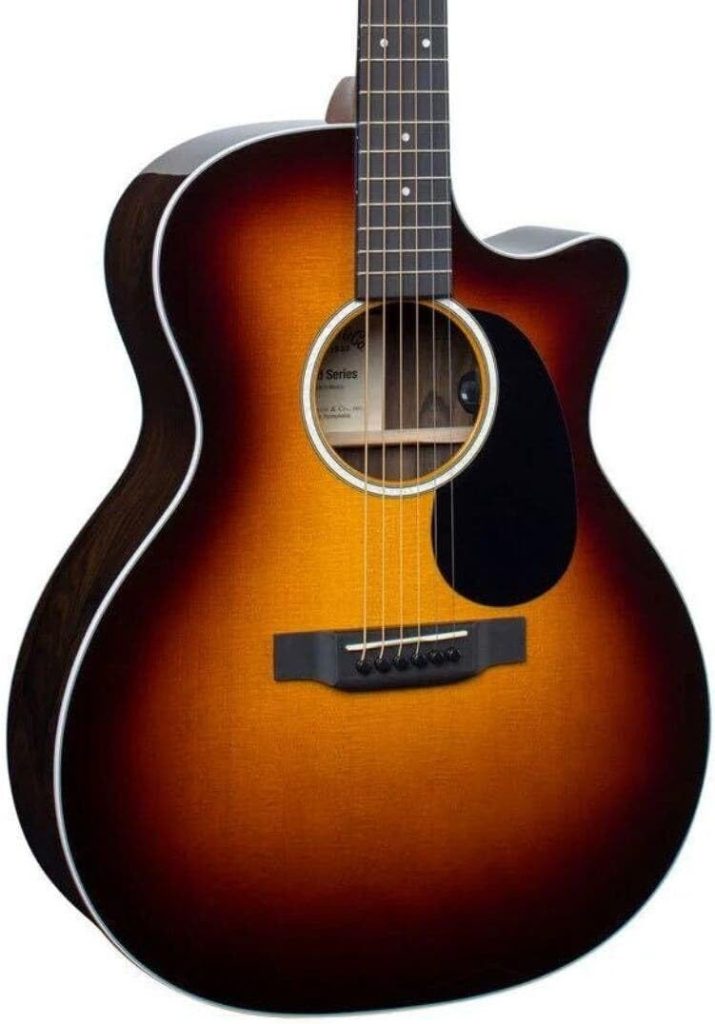
Pictured above: GPC-13E
Grand Performance (GP): A relatively newer design that blends elements of dreadnought projection with more comfortable dimensions.
Martin’s approach to design tends to honor tradition while making subtle refinements. Even modern Martin innovations maintain a connection to the company’s historical designs and construction methods.
Taylor’s Innovative Designs
Taylor has developed a comprehensive range of body shapes to suit diverse playing styles and tonal preferences:
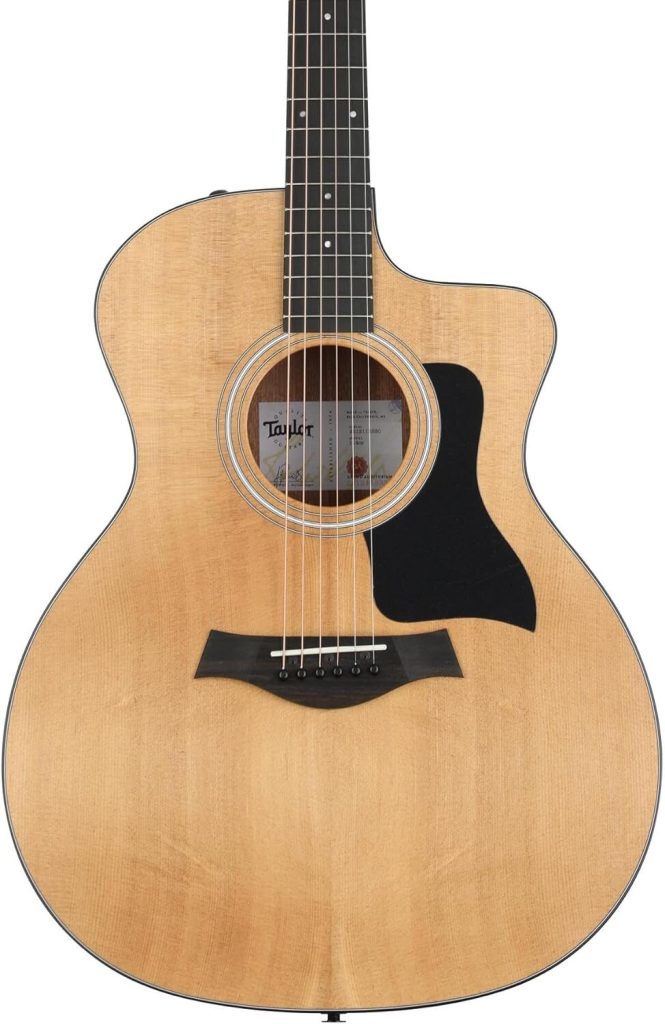
Pictured above: Taylor 114ce
Grand Auditorium (GA): Often considered Taylor’s signature shape, the Grand Auditorium (typically designated by “1” in the model number, such as 314ce) offers remarkable versatility with balanced tone and comfortable dimensions.
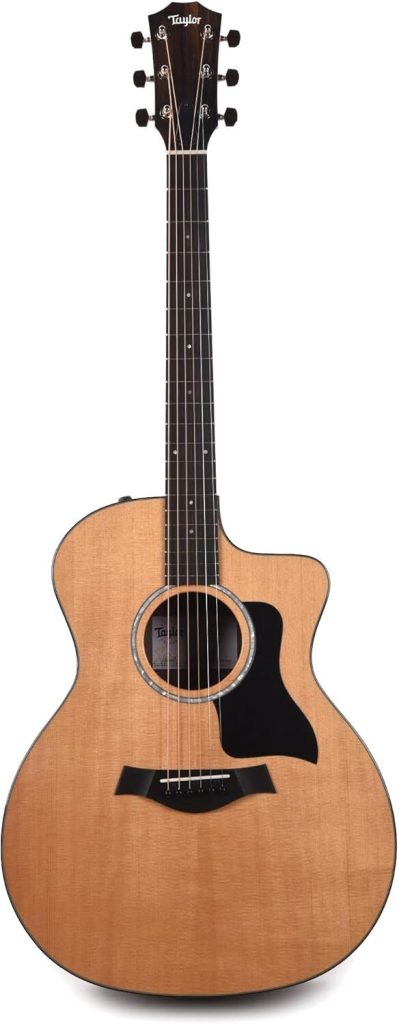
Pictured above: Taylor 212ce
Grand Concert (GC): A smaller body perfect for fingerstyle players seeking clarity and articulation without excessive bass response.
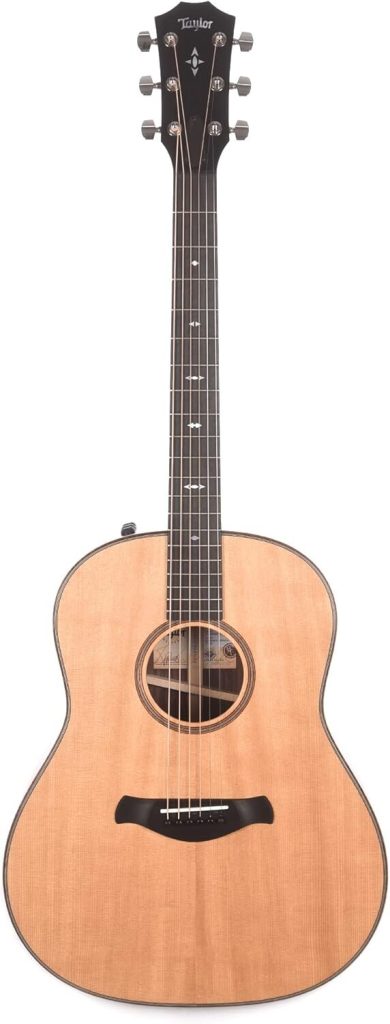
Pictured above: Taylor 717e
Grand Pacific (GP): A relatively recent addition featuring a round-shouldered dreadnought shape that produces a warmer, more vintage tone than typical Taylor models.
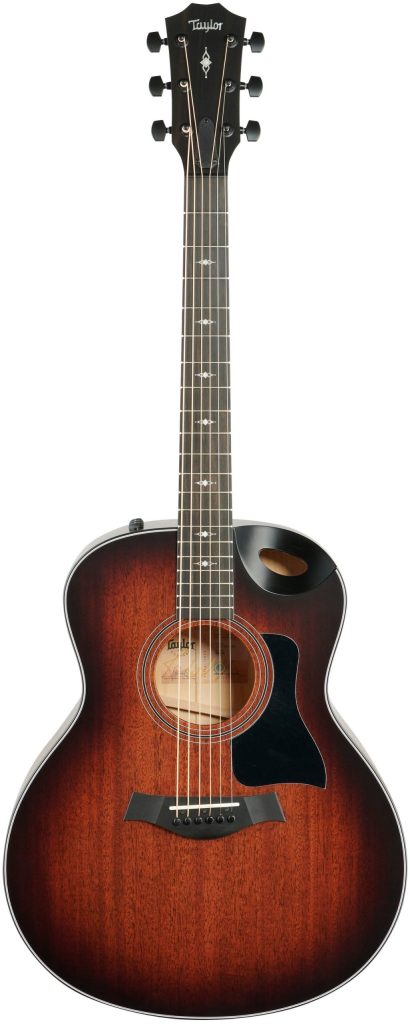
Pictured above: 326ce
Grand Symphony (GS): A larger body with expanded lower bout for enhanced bass and volume while maintaining Taylor’s characteristic clarity.
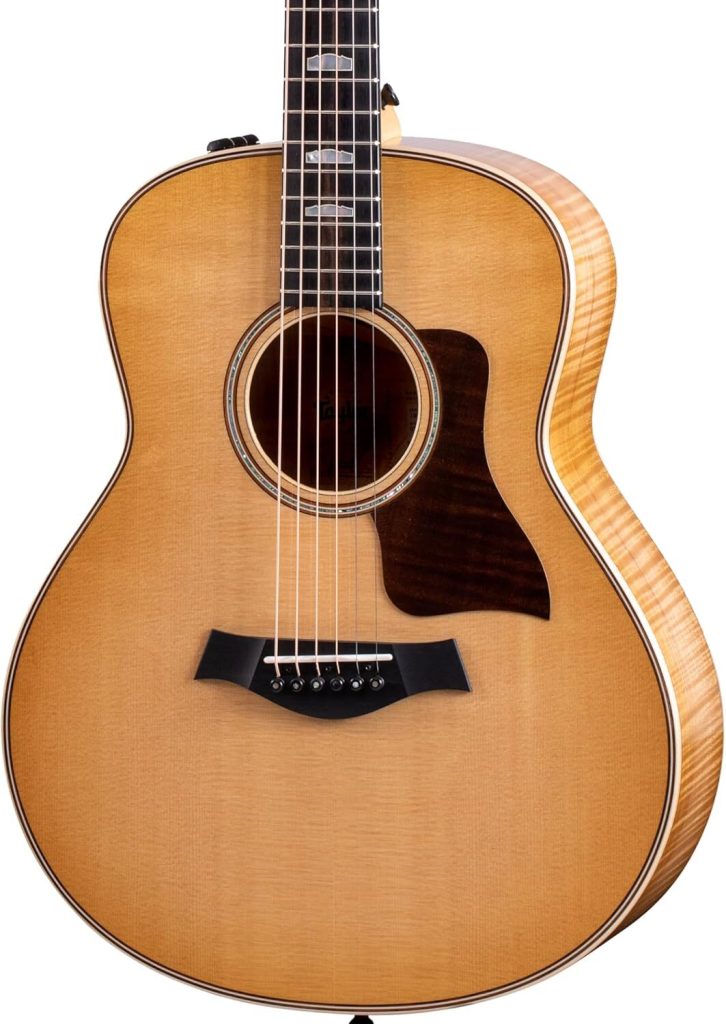
Pictured above: GT611e
Grand Theater (GT): One of Taylor’s newest innovations, offering a compact body with full-scale sound and enhanced playing comfort.
Taylor’s design philosophy embraces innovation, with greater willingness to explore new shapes, bracing patterns, and construction techniques. The company regularly introduces new models and refinements based on player feedback and research.
Playability Considerations
Martin: Traditional Comfort
Martin guitars tend to feature:

- Wider nuts: Many Martin models have a slightly wider nut width (1-3/4″ is common), providing more space between strings—particularly beneficial for fingerstyle playing (shown on right).
- Modified V or Low Oval neck profiles: These traditional shapes provide substantial feel that many players find comfortable for chord work.
- Higher action: Traditionally, Martins come set up with slightly higher action, which contributes to their powerful tone but may require more finger strength, especially for beginners.
Martin playability often improves with age, as the woods settle and the guitar “opens up” tonally. Many vintage Martins are prized for their incredible playability developed over decades of use.
Taylor: Modern Precision
Taylor guitars are renowned for:

- Slim neck profiles: Taylor’s necks tend to be slimmer and more consistent, making them approachable for players transitioning from electric guitars or those with smaller hands (shown on the right).
- Lower action: Taylor guitars typically arrive with lower, more electric-like action that makes fretting notes and chords easier, particularly for beginners.
- Consistent setup: The precision of Taylor’s manufacturing process results in remarkably consistent playability across instruments, even at different price points.
The Taylor NT neck design also allows for easy adjustment, ensuring that playability can be maintained throughout the guitar’s lifetime with standard service.
Manufacturing Approaches
Martin: Heritage Craftsmanship
Martin balances traditional handcraftsmanship with modern efficiency:
- Hand-scalloped bracing: Higher-end Martin models feature hand-scalloped bracing, where skilled luthiers carefully carve the braces to precise dimensions, optimizing the top’s vibration.
- Dovetail neck joints: Many premium Martin guitars still utilize the traditional dovetail neck joint, which offers excellent vibration transfer but requires significant skill to execute properly.
- Hand-finishing: Martin’s sunburst finishes and many cosmetic details are still applied by hand, reflecting the company’s heritage of craftsmanship.
While Martin has incorporated CNC machinery for consistency in certain operations, the company maintains many traditional processes, particularly in their Standard Series and above.
Taylor: Precision Engineering
Taylor pioneered a more modern approach to guitar building:
- Computer-designed components: Taylor utilizes precise computer modeling to optimize bracing patterns, body dimensions, and other critical elements.
- Bolt-on neck design: The revolutionary NT neck attaches to the body with bolts, allowing for precise positioning and easier service throughout the guitar’s life.
- Sustainable innovations: Taylor has invested heavily in sustainable forestry practices and alternative tonewoods, including their proprietary Urban Ash program that repurposes urban trees.
Taylor’s manufacturing approach ensures remarkable consistency while maintaining the essential hand-craftsmanship that affects tone and appearance.
Tonewoods and Materials
Both manufacturers offer instruments crafted from various tonewoods, each contributing distinctive tonal characteristics:
Traditional Favorites
Sitka Spruce: The most common top wood for both manufacturers, offering excellent stiffness-to-weight ratio and broad dynamic range.
Indian Rosewood: Prized for rich bass, complex overtones, and visual beauty, found in Martin’s “28” series and Taylor’s “00” series instruments.
Mahogany: Produces focused midrange with excellent projection and warm character, featured in Martin’s “18” series and Taylor’s “20” series.
Ebony: The preferred fingerboard material for both companies, though Taylor has taken leadership in sustainable ebony harvesting through their Cameroon mill.
Alternative Options
Both companies have expanded their wood selections in response to sustainability concerns and tonal experimentation:
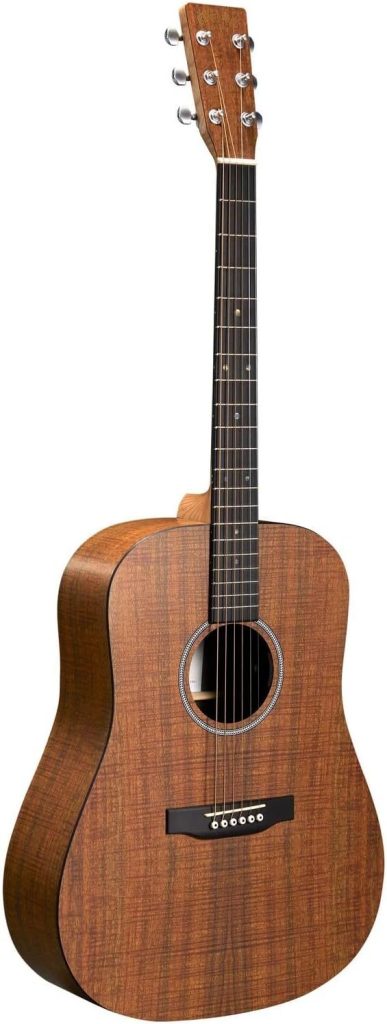
Shown above: Martin D-X1E Koa Acoustic Electric Guitar
Martin offers models with cherry, maple, koa, and sapele, along with their proprietary HPL (High-Pressure Laminate) materials on more affordable models.
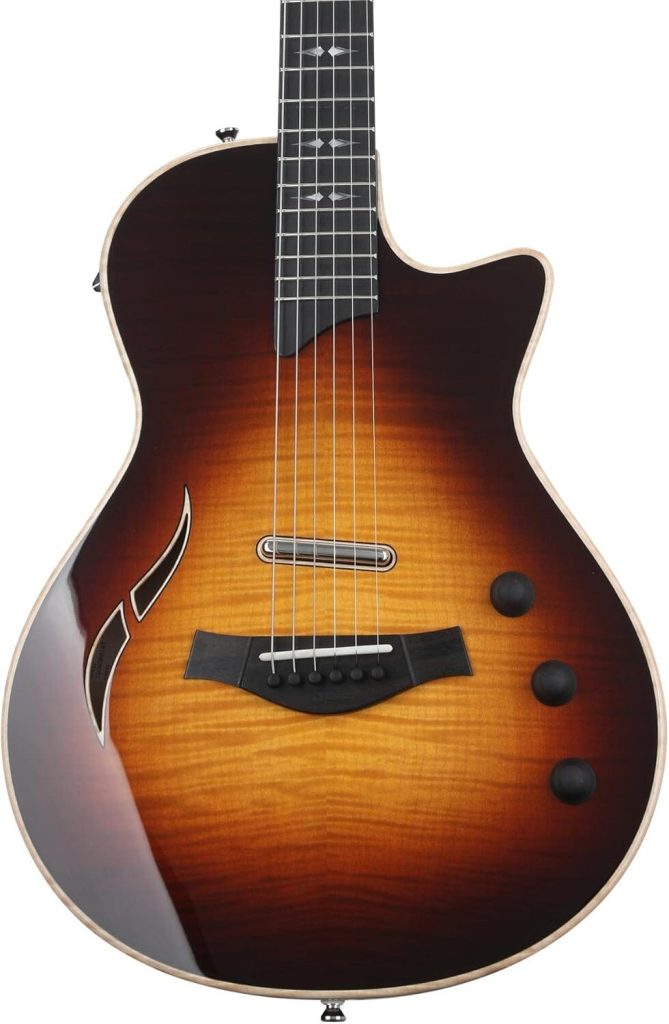
Shown above: Taylor T5z Ashwood Guitar
Taylor has been particularly innovative with woods like Urban Ash (repurposed urban trees), maple, ovangkol, Hawaiian koa, and their layered wood construction in more affordable instruments.
Notable Model Series Comparison
Martin’s Key Series
Standard Series (18, 28, etc.): The flagship models representing Martin’s traditional craftsmanship, with the D-18 (mahogany) and D-28 (rosewood) being particularly legendary.
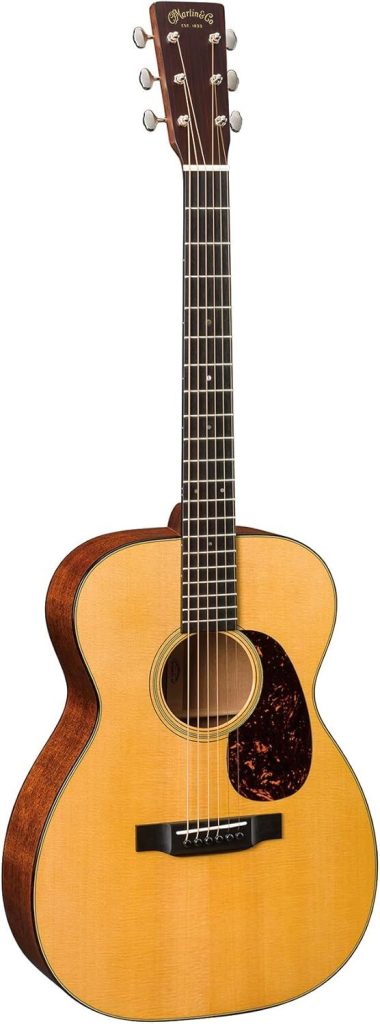
Shown above: Martin 00-18 Standard
Authentic Series: Meticulous recreations of vintage Martin guitars from specific eras, featuring period-correct specifications and techniques.
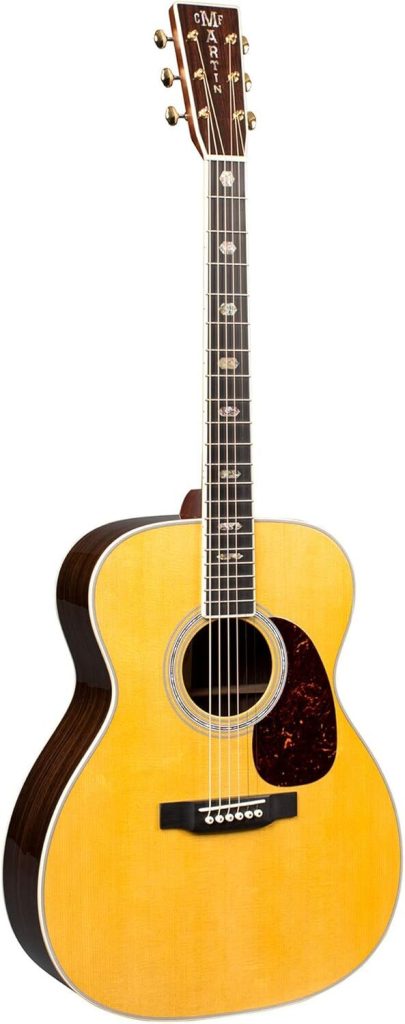
Shown above: Martin J-40
Modern Deluxe Series: Traditional designs enhanced with modern appointments like carbon fiber bracing and titanium truss rods.
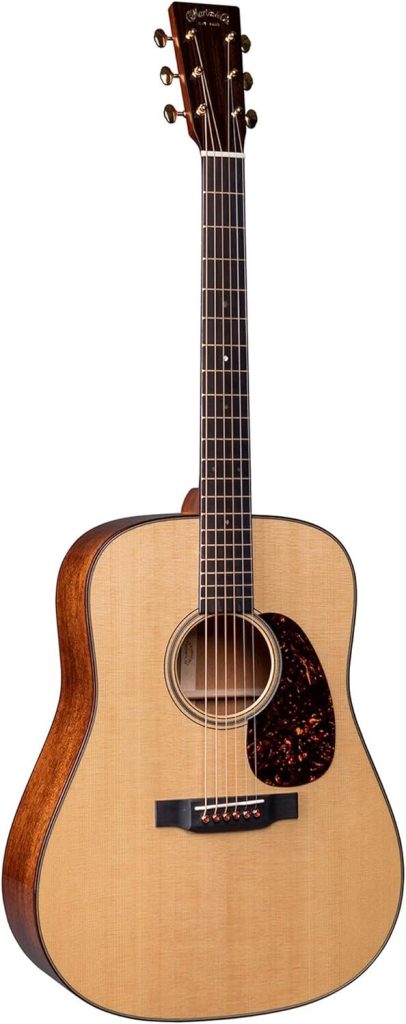
Shown above: Martin D-18 Modern Deluxe
Road Series: More affordable options that maintain Martin’s essential character while incorporating cost-effective materials and manufacturing techniques.
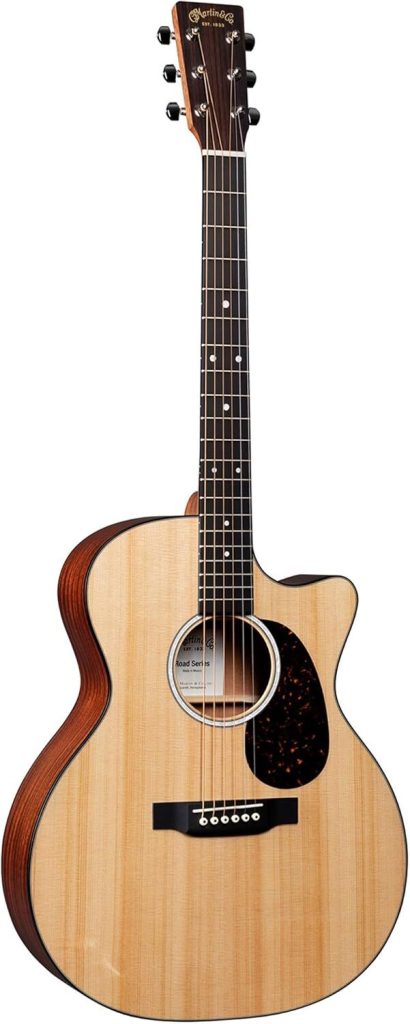
Shown above: GPC-11E Road Series
X Series: Entry-level Martin guitars featuring HPL back and sides with solid spruce tops, providing Martin tone at accessible price points.
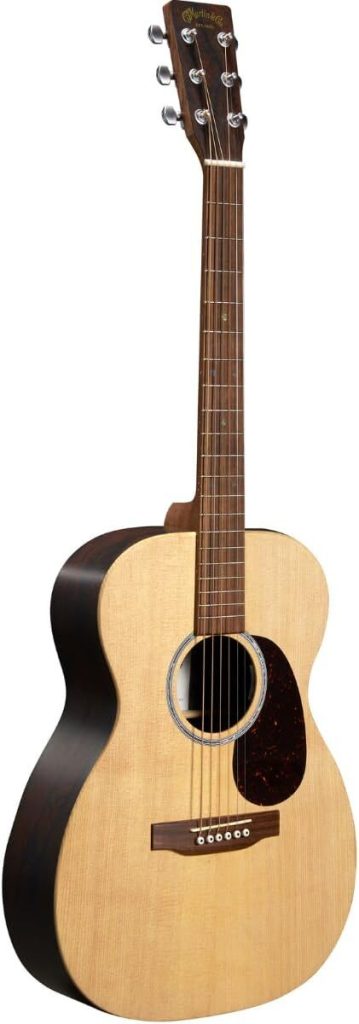
Shown above: Martin 00-X2E
Taylor’s Key Series
200 Series and above: All-solid-wood construction, with the number indicating the wood combination (500 = mahogany, 800 = rosewood, etc.).
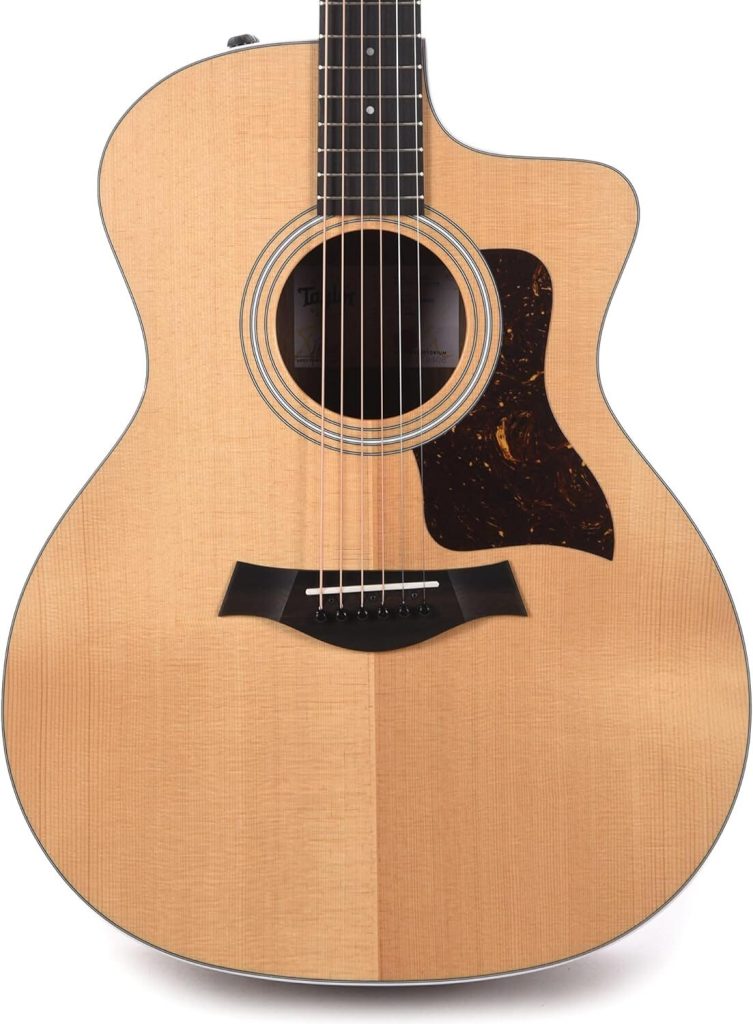
Shown above: 214ce
100 Series: Solid spruce tops with layered walnut back and sides, offering Taylor playability at more accessible prices.
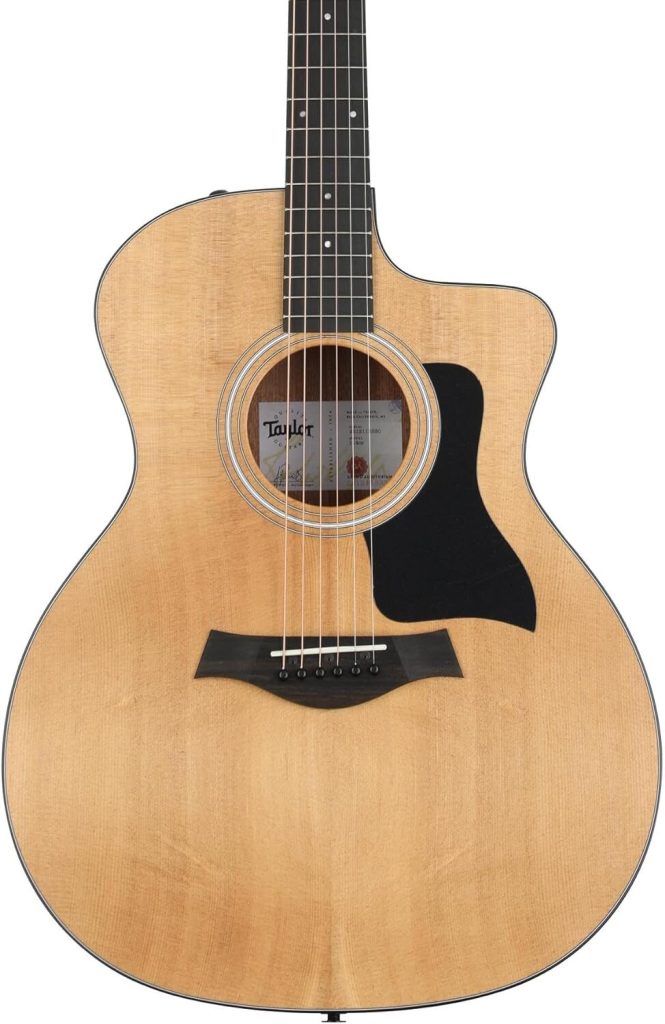
Shown above: 114ce
Academy Series: Designed specifically for beginners and advancing players, with ergonomic features and simplified appointments.
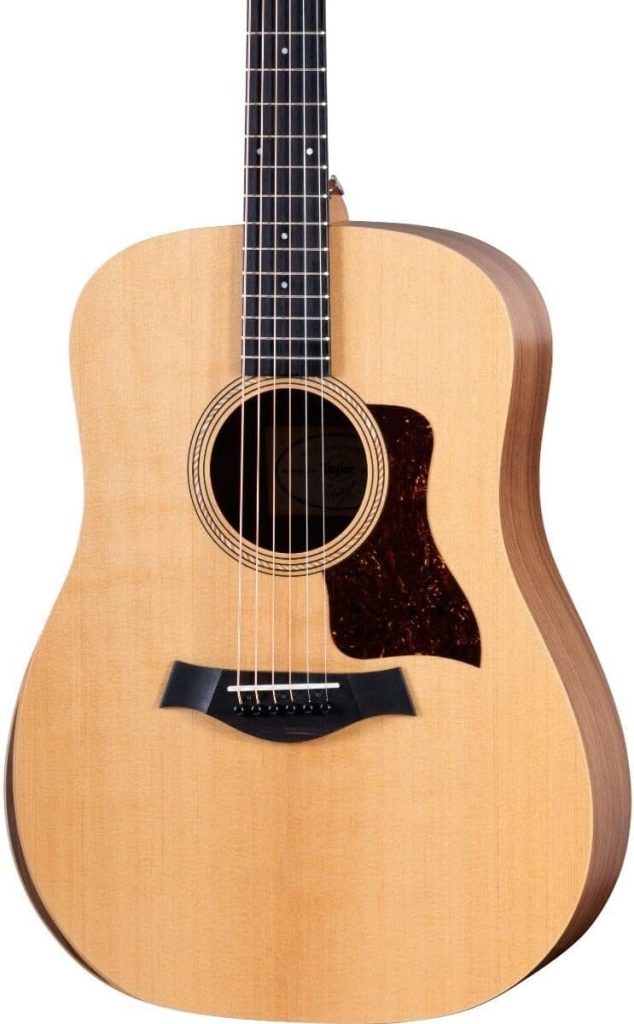
Shown above: Taylor Academy 10e
GT Series: Taylor’s Grand Theater body shape, offering full-scale sound in a comfortable, slightly reduced-size instrument.

Pictured above: GT611e
American Dream Series: Built during the COVID-19 pandemic to maintain production with limited resources, these models offer premium features with simplified aesthetics.
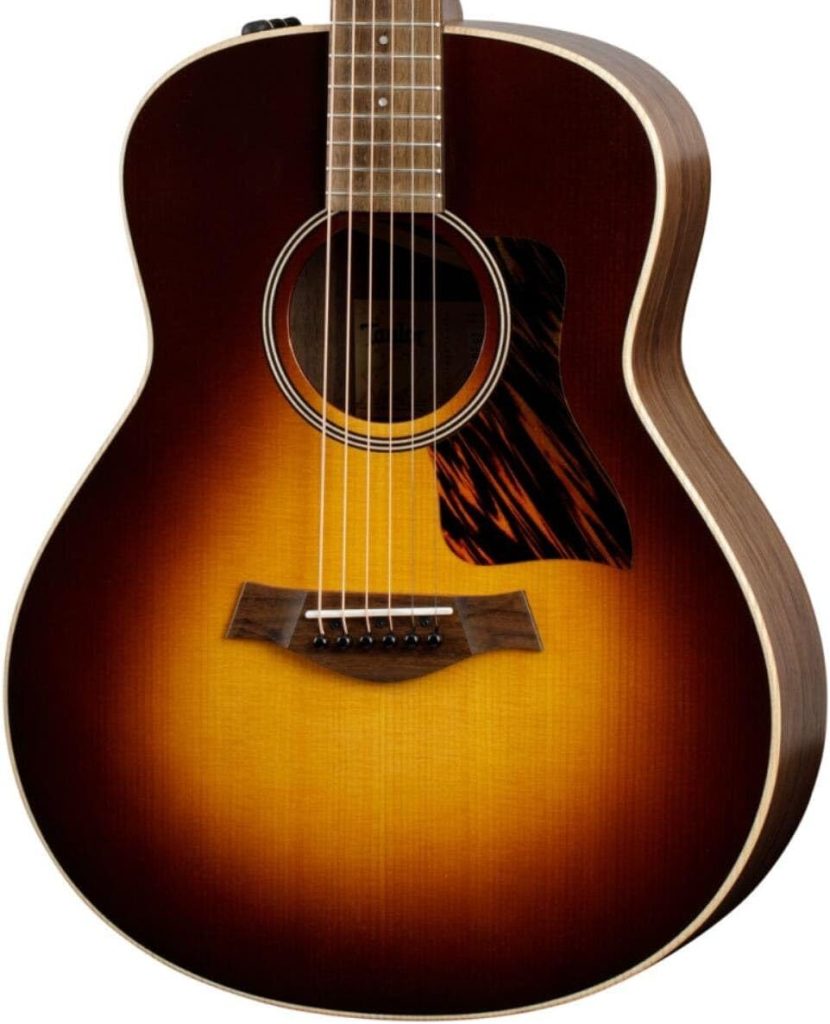
Shown above: Taylor American Dream AD11e
Electronics and Amplification
For performers requiring amplified sound, both companies offer excellent electronics options:
Martin’s Approach
Martin has partnered with Fishman to create pickup systems that capture the natural acoustic sound of their instruments. Most Martin electronics are discrete, preserving the traditional appearance of the guitar while providing reliable amplified tone. The Aura system, available on select models, uses recorded “images” of microphone-captured guitar sounds to enhance the plugged-in experience.
Taylor’s Expression System
Taylor developed their proprietary Expression System pickups in-house, focusing on capturing the natural dynamics of acoustic playing. The current Expression System 2 (ES2) uses behind-the-saddle piezo sensors positioned to respond more like a traditional microphone, preserving the guitar’s natural voice when amplified. Taylor’s commitment to electronics research has made them a favorite among performing musicians who require consistent amplified tone.
Player Experience and Feel
Beyond specifications and features, the subjective experience of playing each brand reveals significant differences:
The Martin Experience
Playing a Martin often evokes a connection to musical history. The guitars feel substantial and respond best to a confident attack, rewarding players with rich, complex tones that seem to carry the weight of tradition. Martin guitars often have what players describe as a “played-in” feel, even when new, and tend to improve dramatically with age as the woods mature and respond to being played.
Many Martin enthusiasts speak of their guitars as heirlooms—instruments that will last for generations while developing more character with each passing year. This sense of heritage and evolution makes Martin guitars particularly appealing to traditionalists and those who value historical connection.
The Taylor Experience
Taylor guitars offer an immediate, accessible playing experience with remarkable consistency. The necks feel sleek and comfortable, and the guitars respond well to various playing styles right out of the box. Taylor’s precision manufacturing ensures that what you experience in the store will be virtually identical to what you receive, making the selection process more straightforward.
Taylor’s modern design philosophy extends to the player experience, with ergonomic considerations evident throughout their lineup. Features like beveled armrests, contoured body edges, and their slim profile necks demonstrate Taylor’s focus on player comfort alongside tonal excellence.
Making Your Choice: Which is Right for You?
The decision between Martin and Taylor ultimately comes down to personal preference, playing style, and musical goals. Here are some guidelines that might help:
Consider a Martin if you:
- Prefer traditional, warm tone with rich bass response
- Play primarily strumming or flatpicking styles
- Value heritage and connection to musical history
- Enjoy instruments that evolve and improve with age
- Primarily play blues, folk, bluegrass, or traditional country
Consider a Taylor if you:
- Prefer bright, articulate tone with excellent note definition
- Play fingerstyle or contemporary strumming techniques
- Value consistency and modern design innovations
- Need reliable electronics for regular performance
- Play contemporary styles or require versatility across genres
Of course, many guitarists ultimately decide they need both a Martin and a Taylor in their collection, as the complementary tonal characteristics make them perfect partners for different musical situations.
Conclusion: Two Paths to Excellence
The “Martin vs Taylor” conversation isn’t really about determining which is better—it’s about appreciating how these two remarkable companies have approached the art of guitar making from different perspectives, each achieving excellence in their own way.
Martin’s nearly two centuries of tradition-informed innovation has produced instruments that connect players to the rich heritage of American guitar craftsmanship. Their commitment to traditional methods and designs has created a distinctive voice that has shaped countless recordings and performances across musical history.
Taylor’s revolutionary approach to design and manufacturing has made high-quality instruments more accessible and consistent, while pushing the boundaries of what an acoustic guitar can be. Their willingness to challenge conventions has resulted in more comfortable, reliable instruments that meet the needs of contemporary players.
Both companies continue to evolve while staying true to their core philosophies. Martin has embraced sustainable practices and modern manufacturing efficiencies without sacrificing their essential character, while Taylor has explored more traditional voicings and aesthetics while maintaining their commitment to innovation and precision.
For the discerning guitarist, the choice between these legendary brands offers an opportunity to connect with different aspects of acoustic guitar tradition and innovation. Whether you choose the warm, historical voice of a Martin or the clear, modern voice of a Taylor, you’ll be playing an instrument crafted with dedication to excellence and a deep understanding of what makes acoustic guitars special.
The best approach? Visit your local authorized dealers, play as many examples from both manufacturers as possible, and let your ears and hands guide you to the instrument that speaks to your musical heart.
Disclaimer: As an Amazon Associate, I earn from qualifying purchases. All product recommendations are based on research and experience rather than direct testing of every instrument mentioned. Specific prices have been omitted as they vary by retailer and change over time.

